Papers by Jane Malcolm-Davies
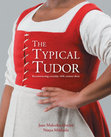
The Typical Tudor: reconstructing everyday 16th century dress, 2022
This book presents a fascinating introduction to the range of garments worn by ordinary men and w... more This book presents a fascinating introduction to the range of garments worn by ordinary men and women 500 years ago. It draws on a wide variety of primary sources for sound evidence of clothing for the mean and middling sort from 1485 to 1603. The Typical Tudor builds on the authors’ previous works 'The Tudor Tailor' (2006) and 'The Tudor Child' (2013) by surveying the available sources with statistical rigour. Most noteworthy of these is the database of more than 57,000 garments and accessories drawn from transcribed wills, accounts, inventories and court records. The book overcomes many of the challenges of research into lower and middle-class dress by diligently cross-referencing multiple categories of evidence to provide a new and comprehensive survey of historical dress for the period. Sources for people’s appearance 500 years ago offer meagre clues compared to the wealth of material recording the elite. The Tudor Tailor’s investigations uncover what is available to help paint a picture of their clothes. Key questions in this hunt for clues are: How representative is what remains? Is any of it typical of the lower and middling sort who lived in the Early Modern era? And how does it help reconstruct their looks and lives? The contradictions and confusions presented by these sources must be approached with caution. How can this patchy evidence provide a picture of what was usual in the Tudor era? What was the range of options for everyday and best dress?
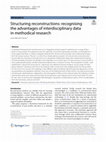
Heritage Science, 2023
A theoretical framework for reconstruction as an integrated scholarly research method across a ra... more A theoretical framework for reconstruction as an integrated scholarly research method across a range of disciplines is long overdue. This paper discusses the usefulness of reconstructed textiles and dress as a template for it. It also argues that there is a need to integrate methods from the arts and humanities with analytical techniques from the natural sciences. The aim is to show how interdisciplinary research not only enriches a reconstruction but provides the mechanism through which cross-disciplinary collaboration takes place. Experimental remaking of historical textiles and dress has tended to be undertaken on an ad hoc basis. For reconstruction to be scientific, it must systematically employ soundly researched evidence from a variety of sources. The triangulation of data-well established in natural and social science-rigorously cross references primary evidence using a range of investigative methods. It produces a firm fix on the material under scrutiny and more credible results than those reliant on only one or two sources. The challenge is that different types of evidence demand specialist approaches, including quantitative and qualitative methods, which are not the traditional tools of dress history. Accurate reconstruction also demands interdisciplinary collaboration: the interrogation of fibres at the molecular level; the collection of observational data at the micro level; and the study of how garments were made and worn at the macro level. This calls for new ways of working with integrated methodologies in pragmatic multidisciplinary teams, which include experts from the humanities, sciences and craft.
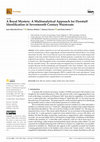
Heritage, 2024
Early modern materials are not well represented in dye and mordant analyses despite extensive doc... more Early modern materials are not well represented in dye and mordant analyses despite extensive documentary evidence suggesting the enormous demand for coloured fabrics, even among those below the elite. Non-wovens likewise receive less attention than woven textiles despite their ubiquity in the early modern historical record. Knitted garments, in particular, have rarely been subjected to dye analysis. One garment is noteworthy for its colourfulness, despite not being visible in formal wear. Men throughout society wore knitted undergarments known as waistcoats from the late sixteenth century. The waistcoats under investigation here are from the collections at the London Museum and the Grimsthorpe and Drummond Castle Trust, Scotland. They are made of silk and are now a pale blue-green colour. Small samples were taken from each and subjected to a series of analytical techniques: micro-Raman spectroscopy, UV-Vis microspectrofluorimetry, and high-performance liquid chromatography (HPLC) coupled with a mass spectrometer. Using this protocol, it was possible to characterise the dyes in the waistcoats by ensuring that maximum information was gleaned from a sample before it was exhausted.
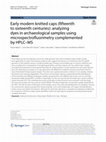
Heritage Science, 2023
The knitted cap was the ubiquitous and most visible garment men wore throughout early modern soci... more The knitted cap was the ubiquitous and most visible garment men wore throughout early modern society, from apprentices to royals. Documentary evidence also suggests that red was a conventional color for specific garments in the sixteenth century, including knitted caps. However, most knitted caps in museum collections are now a muddy brown characteristic of archaeological textiles, and their original color has seldom been studied. Considering the potential of microspectrofluorimetry for analyzing dyes in ancient textiles and manuscript illuminations, this technique was tested on six caps dating from the fifteenth to sixteenth centuries examined in the Knitting in Early Modern Europe research project. The colors are in good preservation condition in two samples, whereas the others show extensive degradation. The emission and excitation spectra acquired allowed the identification of the similarities and differences between samples, grouping them into different dye sources such as cochinealbased and madder-based (RED1 and RED2, respectively). For the coif cap and split-brimmed cap in good condition, analysis through HPLC-MS confirmed the sources of the dyes as Rubia tinctorum and cochineal. It also disclosed the source for another coif cap as Kermes vermilio (RED4). The other knitted items are possibly madder-based (RED3), but HPLC-MS did not allow confirmation of the madder source. The continuing development of a database of excitation and emission spectra acquired from historical textiles, such as the knitted caps, will support the identification of dye sources and specific formulations. Although this technique demands a comprehensive database of references for comparison with the complex signals identified, it allows for rapid spectra acquisition, providing tremendously valuable information.
Fashion Theory, Mar 1, 2003
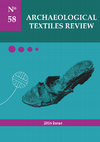
The development of knitting was a key technological innovation of the Medieval and Early Modern e... more The development of knitting was a key technological innovation of the Medieval and Early Modern eras for which there is little published scientific evidence. There are more than 100 knitted caps of the kind worn by ordinary people in the 16th century in museum collections worldwide - an astonishing number given the paucity of extant garments from the period. These are recorded as having been shipwrecked, deliberately concealed, preserved in peat bogs or discarded as beyond use (Fig. 1). Many were unearthed in construction work in cities, during building renovations or discovered on the seabed in far-flung locations – as far north as Norway and as far south as Croatia in Europe, on the east coast of Canada (Kjellberg 1988; Flury-Lemberg 1988) and by 20th century acquisition in North America. A previous study of the caps suggested that they have remarkable similarities in their materials and manufacture which illustrate trade in knitted garments as consumer goods in the emerging Early Modern European marketplace (Malcolm-Davies and Davidson 2015).
Textile analysis is dominated by woven fabrics across all time periods. A variety of other textil... more Textile analysis is dominated by woven fabrics across all time periods. A variety of other textile production methods are attested by the archaeological and historical evidence, including knotting, lacemaking and sprang, and all are worthy of serious study. It is surprising to find knitted artefacts among these under-investigated textiles. The serious scientific study of evidence for early knitting is long overdue. Few knitted artefacts have been comprehensively reported leaving a large gap in the recorded history of textiles. This article sets out the argument for a new protocol to study knitted fabric and an agreed terminology for debating it.
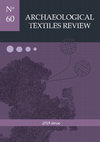
Archaeological textiles review, 2018
Evidence for the development of kni ng as a cra and industry is not as readily available as it is... more Evidence for the development of kni ng as a cra and industry is not as readily available as it is for weaving. The reasons for this include the rela ve scarcity of the archaeological and historical material, its inaccessibility due to incomplete or inaccurate cataloguing, and the lack of agreed terminology for a scholarly discussion. This paper proposes a vocabulary based on English terminology used in tex le analysis, in cra work and in the mechanised kni ng industry today. A recording protocol is required to provide reliable descrip ve detail for those who cannot view the items for themselves and to off er a sound founda on upon which later observers can build with further insights. This paper aims at a protocol for recording kni ed items which may be used as a guideline by experts and non-experts in tex le analysis of knitwork. It cau ons against deduc ons as to methods of construc on without credible evidence and calls for more discussion of appropriate terms in English and other languages.

Archaeological Textiles – Links Between Past and Present NESAT XIII, 2017
New scientific evidence of trade in raw materials and finished goods for the knitted textile trad... more New scientific evidence of trade in raw materials and finished goods for the knitted textile trade is emerging from a scientific study of more than 100 extant knitted caps from the 16th century. These long-overlooked archaeological data are being re-excavated from museum archives for analysis in innovative ways and made available for wider study online. The woollen caps are recorded in European collections as having been shipwrecked, deliberately concealed, preserved in peat bogs, or discarded as beyond use in far-flung locations across Europe-as far north as Denmark and as far south as Croatia. This paper reports the fleece's journey from the sheep's back to the sixteenth century citizen's head based on a variety of evidence, including protectionist legislation, microscopic investigation of the materials used, and modern-day craft expertise. Not only the method of knitting but the choice of yarn, spin, ply, and surface treatments such as fulling, napping and shearing have been successfully recreated, together with the specialist equipment required. Campaigns to protect the capping trade across Europe yielded clues to the proto-industrial settings in which the wool was transformed into a functional fulled fabric providing protection against the weather but also emulating the dress of the elite. Experimental archaeological work with comparative and contemporary craftwork has shed light on the processes required to create the mock velvet nap, which made these caps desirable to those prevented from wearing silk by sumptuary law. The use of x-ray micro-computed tomography scanning as part of an interdisciplinary framework of investigation has shown new ways to explore the materials used to knit and finish the caps. These techniques build on pioneering work with fibre analysis in the 1980s, which identified wool but could not determine specific fleece types and more recent studies which differentiated between early sheep breeds. This new evidence explains how the sheep fleece was crucial to the final appearance of the caps in wear. The knitted caps represent an astonishing body of evidence for the manufacture of ordinary men's clothing and demonstrate the importance of knitting in creating an iconic item of lower-class dress in the Early Modern era.

Church Archaeology, 2008
This paper reports a pilot project to create a visual research resource for 16th century costume.... more This paper reports a pilot project to create a visual research resource for 16th century costume. Church effigies are frequently life-size, detailed and dressed in contemporary clothes. The greatest barriers to their use as reference material are their far flung locations and the lack of a detailed inventory with accurate descriptions. The project reported here investigated the practicality and usefulness of a database of images of effigies as source material for costume historians, costumiers and educators. It produced an online image library of 40 individual effigies or groups of effigies in civilian dress in Hampshire churches including 23 women, 15 men and two mixed gender groups dating from 1510 to 1601 although there were no effigies for 1541 to 1550 or 1591 to 1600. It also highlighted specific difficulties such as the technical demands of database management and the challenge of dating effigies accurately.
Paper presented at The Costume Society’s annual symposium, University of Leicester
Paper presented at the 3rd International Tourism and Festivals Research Conference, organised by ... more Paper presented at the 3rd International Tourism and Festivals Research Conference, organised by Sheffield Hallam University, Innsbruck
Paper presented at the Hawaii International Conference on Social Sciences
Paper presented at the European conference on research methodology for business & managem... more Paper presented at the European conference on research methodology for business & management studies, Reading University
The democratisation of culture has permitted the British bourgeoisie to participate in ways previ... more The democratisation of culture has permitted the British bourgeoisie to participate in ways previously reserved for the elite before the two world wars. Long before that, Napoleon sneered at the English as a nation of shopkeepers. Now, it seems, even the symbols of ...
The project reported here built on a previous pilot study of 16th century effigies in churches as... more The project reported here built on a previous pilot study of 16th century effigies in churches as a three-dimensional resource for costume research. The online database of 40 images in Hampshire churches was expanded with 36 images of effigies in Sussex churches adding further material to the decades already represented and widening the range of dates included. An initial survey of definitions for items of 16th century dress was undertaken to explore the feasibility of describing each effigy's garments in detail. The database was moved to a user-friendly web address (www.tudoreffigies.co.uk) and now offers 76 effigies or groups of effigies for browsing or specific searching by date and/or gender.











Uploads
Papers by Jane Malcolm-Davies
number given the paucity of extant garments from the period. These are recorded as having been shipwrecked, deliberately concealed, preserved in
peat bogs or discarded as beyond use (Fig. 1). Many were unearthed in construction work in cities, during building renovations or discovered on the seabed in far-flung locations – as far north as Norway and as far south as Croatia in Europe, on the east coast of Canada (Kjellberg 1988; Flury-Lemberg 1988) and by 20th century acquisition in North America. A previous study of the caps suggested that they have remarkable similarities in their materials and manufacture which illustrate trade in knitted garments as consumer goods in the emerging Early Modern European marketplace (Malcolm-Davies and Davidson 2015).
A total of 104 knitted items of sixteenth century headwear were identified in European collections as far flung as Eire and Croatia. Some were preserved in peat bogs, others shipwrecked and many more unearthed during building work in cities. The caps and their linings show a surprising homogeneity, given that knitting patterns do not appear to have been circulated until later eras and most cappers learned their trade by eye and experience . The caps were surveyed between 2010 and 2013, using new methods of collaborative investigation to draw the disparate groups together, and modern approaches to glean new information from objects that had not been systematically analysed, although they had been in museum collections for a long time.
The paper concentrates on the 53 examples at the Museum of London, which are now published online, all from early urban archaeological digs in the City of London. They represent a very well-preserved specimen collection sadly without detailed provenance and yet revealing a range of techniques, yarns, colours, finishing quality, and knitting tensions. Comparison with other extant examples provides clear guidance on different constructions with typical features and techniques from which clear classifications were deduced. The paper also looks at the value of using a large group of excavated garments as an intersection between methods used to analyse earlier archaeological textiles, and early modern clothing held in dress collections.
This paper aims to demonstrate what can be learned from these unusual surviving specimens of lower-class sixteenth century dress and suggest what more could be discovered through applying current techniques of fibre and dye analysis.
"
time periods. A variety of other textile production methods are attested
by the archaeological and historical evidence, including knotting,
sprang, lacemaking – all are worthy of serious study. It is surprising
to find knitted artefacts among these under-investigated textiles. The
serious scientific study of evidence for early knitting is long overdue.
Few knitted artefacts have been comprehensively reported leaving a
large gap in the recorded history of textiles. This paper sets out the
argument for a new protocol to study knitted fabric and proposes a
new terminology for discussing it.
professional presentations forming a wide spectrum of events in a variety
of environments (Anderson 1982, 291; Hunt 2004, 387; Thierer 2010, 6,
Konzack 2017, 37). “The trouble with discussing re-enactment as a unified
entity is that it is anything but” (Hartford 2016, 1). Re-enactments range
from scientifically controlled archaeological experiments to themed
private parties. Some attempts at classification have put boundaries around
different types of events and suggested definitions of them. Such literature
stretches back to the early 20th century, when “living history” (an illdefined
catch-all term) first emerged as a genre in the context of open-air
museums and swiftly spread to become a leisure activity as well as a
profession. Even before that, activities featuring the recreation of specific
historic events (such as battle re-enactments) and craft demonstrations
(such as culturally specific handiwork), were produced, often with the
intention of communicating with an audience. Precise and agreed
terminology to describe and define the range of activities under these
various broad headings is still lacking.
A total of 104 knitted items of sixteenth century headwear were identified in European collections as far flung as Eire and Croatia. Some were preserved in peat bogs, others shipwrecked and many more unearthed during building work in cities. The caps and their linings show a surprising homogeneity, given that knitting patterns do not appear to have been circulated until later eras and most cappers learned their trade by eye and experience . The caps were surveyed between 2010 and 2013, using new methods of collaborative investigation to draw the disparate groups together, and modern approaches to glean new information from objects that had not been systematically analysed, although they had been in museum collections for a long time.
The paper concentrates on the 53 examples at the Museum of London, which are now published online, all from early urban archaeological digs in the City of London. They represent a very well-preserved specimen collection sadly without detailed provenance and yet revealing a range of techniques, yarns, colours, finishing quality, and knitting tensions. Comparison with other extant examples provides clear guidance on different constructions with typical features and techniques from which clear classifications were deduced. The paper also looks at the value of using a large group of excavated garments as an intersection between methods used to analyse earlier archaeological textiles, and early modern clothing held in dress collections.
This paper aims to demonstrate what can be learned from these unusual surviving specimens of lower-class sixteenth century dress and suggest what more could be discovered through applying current techniques of fibre and dye analysis.